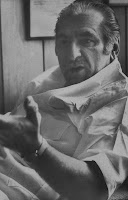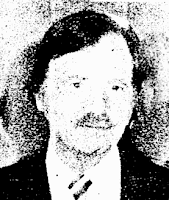Gosnell, the abortion lobby insists, is only an example of what we would see were abortion to again be criminalized.
The abortion lobby seems to forget that first of all, Gosnell arose during the pre-Roe days, already being enabled by prochoice heroes such as Harvey Karman and the Jane abortion ring in Chicago. Had the then-nascent prochoice movement followed the lead of the local feminists -- who were protesting the supercoil experiment and letting the air out of the bus tires outside Gosnell's clinic -- Gosnell would have been recognized as the quack he was, imprisoned, and stripped of his license, and unable to open up and brazenly operate an abbatoir like his Women's Medical Society. Would women really have been worse off if Gosnell had been slapped in irons back in 1972?
What of other "back alley butchers"? It turns out that they, like Gosnell, had their enablers, and were able to flourish in the world of safe-n-legal abortion.
Milan Vuitch
 |
| Milan Vuitch |
On June 15, 1974, seventeen-year-old Wilma Harris of West Virginia went to Vuitch's Laurel Clinic for a safe and abortion. Five days later, she was dead. Wilma's family sued, noting that Vuitch and his staff had allowed Wilma to lapse into a coma and lie unattended for 12 hours before transferring her to the hospital.
Vuitch administered general anesthesia himself for an abortion he performed on Georgianna English on January 12, 1980, and she never woke up. When Vuitch was investigated, it was discovered that he kept patients overnight in his home (an unlicensed facility) which he designated "The Annexe." Inspectors also noted repeated violations of medical standards regarding sanitation and anesthesia. Vuitch also admitted during another case that he had lacked hospital admitting privileges since 1963.
WDVM-TV, Washington, D.C. won the Peabody Award for its investigation of Vuitch uncovering how Vuitch's practice had been cited for a multitude of violations, such as in 1980 for dirty instruments and lab specimens being refrigerated with food; in 1981 for taking patients to Vuitch's home overnight and having expired drugs; in 1982 for unlicensed drug distribution and mixing dirty and clean surgical instruments and for a patient sent home though she was passing red urine and had a catheter still inside her body; in 1983 for having anesthetic drugs "not freshly prepared and yellowish in color". The investigator also noted that despite these violations, the city kept renewing the clinic's license until 1982, after which Vuitch just operated without one.
In spite of the terrible toll on Vuitch's patients, he remained a hero to the prochoice movement and was hagiographically eulogized upon his death in 1993.
Jesse Ketchum
Less well-known than Vuitch was Dr. Jesse Ketchum. Vuitch was a crusader. Ketchum was just an abortionist. He operated his abortion practice alongside a legitimate (if somewhat lawsuit-prone) medical practice. Although Ketchum's criminal abortion practice wasn't the best in the world, he evidently maintained some standards and protocols for screening patients. No patient deaths have been attributed to Ketchum's criminal practice, which was largely supplied with patients via Clergy Consultation Services, an abortion advocacy group which rather than address women's issues simply ensure that by hook or by crook (literally, in their referrals to the likes of Jesse Ketchum), they got their abortions..
Ketchum was arrested when an undercover policewoman arranged for him to perform an abortion at a motel in Southfield, Michigan, and his case was taken up by abortion advocates who rallied on his behalf.
When New York legalized abortion on demand in 1970, Ketchum set up shop in a Buffalo motel suite. For Ketchum, New York must have seemed like the Promised Land. Abortionists were flaunting safety standards with impunity. Practices such as injecting patients with saline then sending them home to abort raised eyebrows, to be sure, but they didn't get anybody thrown in jail.
On May 28, 1971, Ketchum seriously injured a woman in a botched abortion, but no harm befell him. Ketchum decided to do hysterotomy abortions -- which involve slicing the uterus open to remove the baby -- in his office. It didn't take long for this practice to turn deadly. In the second half of 1971, Ketchum caught the eyes of the authorities by allowing two hysterotomy patients to bleed to death.
His first victim was 25-year-old Margaret Smith, who had traveled from Ketchum's home state of Michigan to New York for a safe and legal abortion because she had been exposed to rubella. Ketchum performed a vaginal hysterotomy on Margaret at 10:30 the morning of June 16, 1971. Margaret was then left virtually unattended until her boyfriend returned at 2:00. He found Margaret unresponsive, and begged Ketchum and his staff to do something. Paramedics were summoned, but they were unable to revive Margaret. She was taken to a hospital across the street from Ketchum's office, where she was pronounced dead on arrival. Margaret's vagina had been sutured, but a laceration in her uterus and cervix had not been repaired. She had bled to death.
Ketchum was verily astounded when he was charged with criminally negligent homicide in Margaret Smith's death. Eidently he didn't think the state could possibly succeed in their case. He kept taking risks with patient's lives Before his case even went to trial, he performed a similar abortion on 37-year-old Carole Schaner of Ohio on October 20, 1971, who was sent back to her motel to die of injuries similar to those that had killed Margaret Smith.
Ketchum was convicted for Margaret's death on October 26, 1973, despite the fact that Milan Vuitch testified on his behalf. When Roe v. Wade was handed down and assorted criminal abortionists started getting their old convictions thrown out, Ketchum tried Roe for leverage. He got nowhere. Eventually, he was sentenced to prison. Ketchum served little time, however. He was released after less than a year, and relocated to Florida where he managed not to kill any of his patients as a staff physician at a VA hospital in Miami, from September of 1976 to November of 1977. It turned out that no license was required for a doctor to practice in a government operated hospital. According to the medical board licensee lookup, Ketchum lives on Michigan now. His petitions to restore his medical license, made in 1984 and 1987, were both denied. Nevertheless, despite killing two women, he remains a free man.
Benjamin Munson
 |
| Dr. Benjamin Munson |
 Dr. H. Benjamin Munson performed abortions in Rapid City, South Dakota. He opened his practice in 1967. He was convicted in 1969 for performing an abortion on a 19-year-old patient. Munson challenged his conviction, winning in circuit court. The state appealed, and the South Dakota Supreme Court ruled against him. He appealed this decision, which was rendered moot by Roe. In 1973, Munson discharged 28-year-old Linda Padfield after an incomplete abortion. She died of sepsis three days later. Munson was charged with manslaughter. Yvonne Mesteth paid with her life when Munson made the same screw-up with her that had killed Linda Padfield. Though not as celebrated as Vuitch, Munson was nevertheless considered altogether respect-worthy because of his purported courage in doing abortions. Seventh Circuit Judge Merton Tice, Jr. instructed the jury to acquit, saying that the state's case was inadequate because prosecutors could not prove that Munson intended harm to his patient. Thanks to having a friendly judge, Munson remained free to continue his practice, even joining the prestigious National Abortion Federation, and 18-year-old
Dr. H. Benjamin Munson performed abortions in Rapid City, South Dakota. He opened his practice in 1967. He was convicted in 1969 for performing an abortion on a 19-year-old patient. Munson challenged his conviction, winning in circuit court. The state appealed, and the South Dakota Supreme Court ruled against him. He appealed this decision, which was rendered moot by Roe. In 1973, Munson discharged 28-year-old Linda Padfield after an incomplete abortion. She died of sepsis three days later. Munson was charged with manslaughter. Yvonne Mesteth paid with her life when Munson made the same screw-up with her that had killed Linda Padfield. Though not as celebrated as Vuitch, Munson was nevertheless considered altogether respect-worthy because of his purported courage in doing abortions. Seventh Circuit Judge Merton Tice, Jr. instructed the jury to acquit, saying that the state's case was inadequate because prosecutors could not prove that Munson intended harm to his patient. Thanks to having a friendly judge, Munson remained free to continue his practice, even joining the prestigious National Abortion Federation, and 18-year-old Sidney Knight
Dr. Sidney Knight was facing a number of criminal abortion charges in 1973, when Roe v. Wade made them a moot point. He hung out his shingle and began performing abortions legally. In March of 1974, Janet Blaum went to Knight's New Orleans facility for a safe and legal abortion. Five days later, on March 11, she was dead of brain hemorrhage. Janet's ex-husband sued Knight on behalf of the couple's children, alleging that Knight had administered a fatal dose of anesthesia while preparing Janet for the abortion.
Others?
I know there are other "back alley butchers" who simply started advertising and practicing more openly after legalization. Erstwhile criminal abortionist Hipolito Barreiro (who, like Vuitch, Ketchum, Munson, and Knight, had no pre-legalization deaths I've been able to find out about) hired some marginal doctors and opened a safe and legal abortion facility in Miami that killed four abortion patients from 1979 through 1983. I have no doubt that other erstwhile "back alley butchers" have found legalization to be quite a boon.
It's a shame that women pay with their lives so that abortionists can sleep easier.

No comments:
Post a Comment